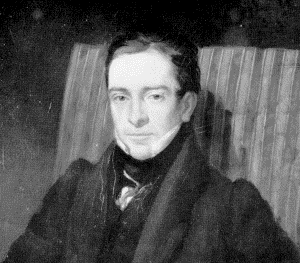So, Who Was Thomas Hood?
JUST ABOUT every sewing machine history mentions the famous "Song of the Shirt" poem in which Thomas described the plight of the early-Victorian seamstress.
I got to wondering just who this Thomas Hood was and, with the help of the Internet, came up with this chronology GF

1799
Thomas Hood born May 23 in London, son of a bookseller and publisher of Scottish origin.
1811
Death of Hood's father forces change in educational plans.
1813
Hood forced to leave school to take position as clerk in London.
1814
Hood becomes interested in engraving through the influence of his uncle, a prominent engraver.
1815
Autumn, Hood has physical breakdown; journeys to Dundee to recover health and visit relatives.
1816
Still at Dundee, writes "The Bandit," a narrative poem somewhat in the vein of Sir Walter Scott and Lord Byron.
1817
Autumn, returns to London with the idea of following engraving as a profession.
1819-21
Hood working as an engraver. Makes occasional contributions to a fortnightly literary society journal. Early summer, 1821, joins staff of the London Magazine. July, mother dies, leaving Hood's four sisters in his care.
1821-23
Working as "a sort of sub-editor" on the London Magazine. Meets Charles Lamb, J. H. Reynolds, Thomas De Quincey, William Hazlitt, William Wordsworth, and other prominent literary figures. Around June, 1823, severs association with the London Magazine.
1825
February, Odes and Addresses to Great People, by Hood and Reynolds, published with great success. May, marries Jane Reynolds.
1826
Publishes First Series of Whims and Oddities, which is very well received by the public and praised by Blackwood's. May(?)-August, employed as dramatic critic for The Atlas.
1827
February, publishes National Tales, a collection of stories, and in July, The Plea of the Midsummer Fairies, Hero and Leander, Lycus the Centaur, and Other Poemsboth in the "serious tone," and both failures. October, Second Series of Whims and Oddities issued with great success.
With fingers weary and worn,
With eyelids heavy and red,
A woman sat, in unwomanly rags,
Plying her needle and thread -- Stitch! stitch! stitch!
In poverty, hunger, and dirt,
And still with a voice of dolorous pitch
She sang the "Song of the Shirt"
1828
Writes a mediocre farce, York and Lancaster or a School without Scholars (one of several lackluster comedies attempted by Hood). October, begins editing The Gem, a "Christmas annual"; contributes to it "The Dream of Eugene Aram" and other pieces.
1829
Becomes one of the proprietors of The Athenaeum, a new and promising journal. September, scores a triumph with "The Epping Hunt."
1830
Hood brings out his first Comic Annual (to appear yearly 1830-39 and again in 1842), which is highly successful and widely imitated. Daughter, Frances, born.
1831
June, Hood unwisely ends his official connection with The Athenaeum, but continues to contribute to it
1832
Moves with his family to a country house in Essex.
1833
Working on a three-volume novel, Tylney Hall. Harassed by poor health and heavy expenses.
1834
Hood quarrels with his publisher, C. Tilt; replaces him with A. H. Baily. October, Tylney Hall published and sells well, but Hood's finances still precarious. December, saddened by death of Charles Lamb.
1835
Son, Tom, born. March, financial disaster sends Hood temporarily to the Continent. At Koblenz, plans a "German book"; continues work on Comic Annual and other projects.
1836
Supports Thomas Noon Talfourd's efforts toward reform of copyright law by writing for The Athenaeum a series of letters titled "Copyright and Copywrong." Winter, reveals increasing humanitarian concern with the poem "Agricultural Distress."
1837
June, moves with family to Ostend, Belgium. Continues work on Comic Annual. Autumn, planning Hood's Own, a monthly magazine.
1838
January, first issue of Hood's Own appears and wins instant popularity, but Hood's finances still critical. Returns to England for brief visit.
1839
Early in year, Hood in England briefly to consult Dr. Elliot about his health and to check into Baily's practices. Publishes the thirteen numbers of Hood's Own as a collected volume. December, publishes his "German book," Up the Rhine (dated 1840).
1840
Up the Rhine a phenomenal success, but Hood's income tied up through litigation with Baily. Summer, the Hood family finally reunited in England. November, Hood's Athenaeum review of Dickens' Master Humphrey's Clock leads to lasting friendship between the two writers. Scores a great hit with "Miss Kilmansegg and Her Precious Leg."
1841
Financial situation relieved somewhat by grant from Royal Literary Fund. August, Hood succeeds to editorship of the New Monthly Magazine upon death of Theodore Hook.
1842
Receives many marks of esteem from Dickens and other literary celebrities. June, publishes two more letters on copyright in The Athenaeum. Still editing the New Monthly Magazine.
1843
September, vacations with son in Dundee; visits Edinburgh and is entertained by Lord Jeffrey. October, quarrels with publisher of the New Monthly Magazine and resigns editorship. December, creates a sensation with "The Song of the Shirt"; publishes Whimsicalities (dated 1844).
1844
January, begins publication of Hood's Monthly Magazine and Comic Miscellany; sales are excellent, but again Hood has trouble with his publisher. Health collapses, and friends rally to keep the magazine on its feet. May, "The Bridge of Sighs" wins great acclaim. November, Mrs. Hood placed on civil pension list. Hood still trying to work while propped up in bed.
1845
May 3, Hood dies.
This extract is taken from Lloyd N. Jefferey, Thomas Hood (New York: Twayne Publishers, 1972)






